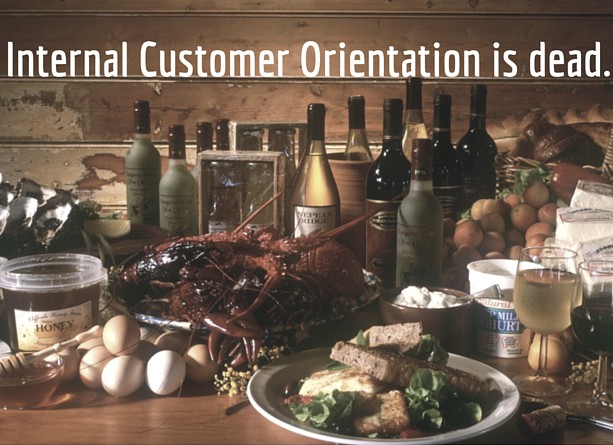Internal Customer Orientation
In 1992 I wrote my master’s thesis about internal customer orientation. The most important part of that thesis was about how to measure the internal customer satisfaction. I chose to do the research for the HR departments of a chemical company, a psychiatric hospital and a utilities supplier. I used the frame of SERVQUAL, developed by Parasuraman, Zeithaml & Berry. That model was quite popular in the early 90’ies. Internal customers of the HR department could rate the services they received from that HR department.
The topic of (internal) customer orientation was hot then, as it is now and as it has always been. It’s not that we have suddenly discovered the customer as prime source of meaningfulness and growth. Companies have not stopped looking for ways to optimize their customer strategy all along. As far as customer intimacy was their strategy, a great deal of effort went to service quality improvement. Let’s not forget that some companies do not focus on customer service as differentiator, but more on operational excellence or product leadership.
The game has changed
I recently browsed through that master’s thesis. It’s amazing that we still talk about similar stuff. As if we haven’t learned much. But something has changed since then. Digitalisation is changing the customer experience and is altering the rules of the game. Where the service towards the customer is becoming digital, the efforts a company and its people should do to connect with the customer become bigger. Customers have become more demanding than ever.
So can you imagine there would still be room for an internal focus? Companies must act in an agile way in the face of changing customer demands, and any internal focus leads to waste of energy, time andfocus. In the end it leads towards a mediocre customer experience.
And that’s why internal customer orientation is dead.
The sources of waste
But we still talk about it. This has the risk of creating waste for several reasons.
- The nature relation between internal units is usually different than between a company and its customers. Even when an organization introduces ABC and considers internal service providers as profit centers, at the end it will still be the final customer that should be the main source of inspiration.
- Discussions about internal customer service do not lead to improvement of external service quality.
- Internal customer orientation allows internal departments to keep their distance to the external customer.
- Internal customer satisfaction has no value in itself. Could it be that all internal customers are satisfied, but the end customer is not?
- Focus on the internal customer satisfaction could lead to consumerism or even entitlementitis (the feeling to be entitled to a better internal service quality).
- For internal departments it’s not always easy to focus on the external customers. HR, Finance, IT, Legal have a hard time translating their activities into customer driven processes.
The way forward
There are many things we can do to cut the focus on internal customer orientation.
- Build end-to-end processes in which every unit finds its place and contributes towards external value-creation.
- Define what internal departments should do to strengthen the service towards the customer.
- Define optimal internal processes that are as lean as possible and hook into the main value chain.
- Build a culture that breathes the external customer. The discussion should not be about “what you can do for me” but “what can we do together for the customer“.
- Focus on what drives the business in terms of customer needs.
- Build multidisciplinary teams around the customer needs. These teams include the internal departments
Internal Dissatisfaction is not an option
This does not mean that internal satisfaction is not relevant for customer service. On the contrary. We know that how people behave determines the customer experience. Behaviour is not only about actions. It’s also about emotions and attitudes.
This blog does not want to minimise the quality of an internal system. However, if that internal system is not inspired by the external customer, it creates inefficiencies and waste.
The attention we give to ourselves, we cannot givento the customer.
A culture drenched in the awareness of the importance of the customer is one of the key factors of success. Someone should not be satisfied about the service he gets from any internal supplier as such. He should be satisfied about the coöperation in the face of the customer needs. He should be thrilled about his experience in the organisation as a whole.
Internal customer orientation is dead. The people experience is alive.






If the statement that, “internal customer orientation is dead” is indeed true (which I disagree with) then it becomes a sad commentary on managements resistance to comprehensively understand who drives customer satisfaction–employees! Traditional management rules by coercion and compliance and not by cooperation. When employees feel coerced or “ordered” their level of fear and uncertainty increases substantially. That fear and uncertainty experienced by employees, without question, hurts engagement and engaging with customers (i.e. customer satisfaction). And, the worst part is that organizations know this!
One reason for this willful neglect is that management and top executives also feel uncertain and afraid (all be it for different reasons) and that uncertainty and fear drives management to continue attempts to control their surroundings and the people whom they manage. Attempting to control the events, people, and environment around them gives management the illusion of feeling safe. Those feelings further drives them for more and more control. The more management drives for control, the more fearful employees become and a vicious downward spiral ensues. In the absence of someone to look out for them and their safety, employees will protect themselves–at the expense of customer service and positive engagement in their work. managers, and the organization.